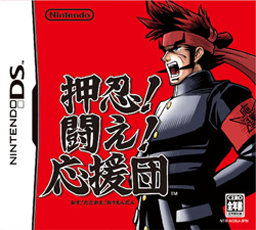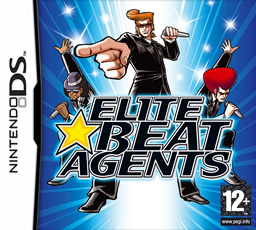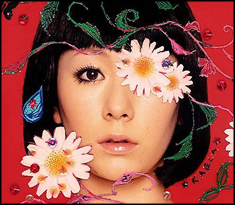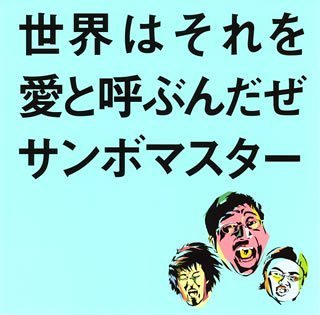OSU, Osu, or osu can stand for:

An ōendan (応援団), literally "cheering squad" or "cheering section", is a Japanese sports rallying team similar in purpose to a cheerleading squad in the United States, but relies more on making a lot of noise with taiko drums, blowing horns and other items, waving flags and banners, and yelling through plastic megaphones in support of their sports team than on acrobatic moves. In addition to cheering for their own teams, ōendan have been known to lead fans in cheers which tease and taunt the other team and its fans. This is usually done in the spirit of good competition, but occasional fights have broken out if the taunting gets too heated. Smaller ōendan are sometimes called ōenbu.

Osu! Tatakae! Ouendan, or Ouendan, is a rhythm video game developed by iNiS and published by Nintendo for the Nintendo DS handheld game console in 2005, for release only in Japan. Ouendan stars a cheer squad rhythmically cheering for various troubled people, presented in-game in the style of a manga comic. In each stage, players use the DS touchscreen to tap specifically marked spots that appear in rhythm to various Japanese pop songs, scoring points for accurate timing and avoiding a poor performance which can cause the stage to end prematurely. Though never released in Western markets, it was a popular import to these regions, leading to the development of the Westernized spiritual sequel Elite Beat Agents, as well as a direct Japanese sequel Moero! Nekketsu Rhythm Damashii Osu! Tatakae! Ouendan 2.

Elite Beat Agents is a rhythm video game developed by iNiS and published by Nintendo for the Nintendo DS. It was released in North America, Europe and South Korea. As the second of three rhythm games developed by iNiS specifically for the DS, it is the spiritual sequel and international counterpart to Osu! Tatakae! Ouendan, a Japanese rhythm game released in 2005, sharing many common elements with it.
Kishidan (氣志團) is a Japanese rock band. They have a retro image, wearing Japanese school uniforms in the style of bōsōzoku. The lead singer, Sho Ayanokoji, was DJ Ozma, until he retired in December 2008. Kishidan announced a "comeback", after a three-year break, on January 27, 2009. The band had never officially split up, but had been taking a break while Show and Hikaru were working on the DJ Ozma side project. Their song, Omae Dattanda released on November 10, 2009, was used for the 11th ending theme song for Naruto Shippuden. They are signed to Avex Trax and are managed by Sony Music Artists. Their song, Warera Omou, Yue ni Warera Ari, is used for the opening theme song for Kamen Rider Ghost, released on December 9, 2015

"Glamorous Sky" is Mika Nakashima's 16th single overall, her 1st under the name Nana starring Mika Nakashima, and the second most successful single in her career after "Stars". It is her first rock song and it was used as one of the image songs for the film Nana. Hyde of L'Arc-en-Ciel composed "Glamorous Sky". The second and third B-sides, "Blood" and "Isolation" were used as CM songs for Kate cosmetics. Mika Nakashima graces the cover of the single as Nana Osaki.

"Go My Way" was the fourteenth Japanese single release from Hitomi Yaida. It is also the first single released from the album It's a New Day.
Mihimaru GT were an urban and pop music group signed to Universal Music Japan and managed by Tearbridge Productions, a subsidiary of Stardust Promotion and Avex.
Kotaro Umeji is a Japanese graphic designer. He has shaped the image of U-1 and other characters from the video game Gitaroo Man for the PlayStation 2 video game console and Gitaroo Man Lives! for the PlayStation Portable video game console, and the characters and art found in Osu! Tatakae! Ouendan and Elite Beat Agents both for the Nintendo DS video game console.

"RIRURA RIRUHA [リルラ リルハ]" is the third single by Japanese pop singer Kaela Kimura, and the first from her album Circle. Released March 30, 2005, it peaked at number three on the Japan Oricon singles chart, Kimura's highest charting single to date. By the end of 2005, Real Life Real Heart had sold 117,299 copies.
Going Under Ground (ゴーイング・アンダー・グラウンド) are a Japanese alternative rock band, formed in Okegawa, Saitama, 1991. Sometimes referred to as just "Going", they got their name from the British hit single, "Going Underground" by The Jam.

"Sekai wa Sore o Ai to Yobundaze" is the Japanese rock band Sambomaster's fifth single.

"Pop Star" is a song by Japanese singer Ken Hirai. The single went on to top the 2005 Oricon Charts and is known for its remarkable music video, featuring Ken in seven different personas, including a raccoon and his own manager. The Video also helped Hirai break into the US and Canadian Markets where stations would play the video despite the fact that it was in Japanese. The song was featured in the Nintendo DS game, Moero! Nekketsu Rhythm Damashii Osu! Tatakae! Ouendan 2, as well as on Taiko No Tatsujin 8 and Taiko No Tatsujin Portable 2 for the PSP. It is also a track in the Konami's Jubeat Ripples series. Its latest appearance is in the Namco game Happy Dance Collection for the Nintendo Wii. The song was also featured in the Japanese drama Kiken na Aneki starring Ito Misaki.

"Countdown" is the sixth single by Japanese singer Hyde, and the first single from his third solo album Faith.

Jubeat, stylized as jubeat, is a series of arcade music video games developed by Konami, and is a part of Konami's Bemani line of music video games. The series uses an arrangement of 16 buttons in a 4x4 grid for gameplay, a grid also used for the displaying of cues and part of the user interface.
Keiichi Yano is a Tokyo-based video game designer and musician responsible for a number of music video game titles including his most famous game, the 2002 cult video game, Gitaroo Man. Yano has been involved in music from a young age and he earned a major in jazz studies at the University of Southern California. He has spent time playing saxophone in Tokyo jazz clubs.

"Monkey Magic" is a song by Japanese rock band Godiego, serving as their 8th single. It is internationally known as the opening theme for the 1978 television series Saiyūki, known in the west as Monkey. The song peaked at #2 on the Oricon Charts and #4 on The Best Ten.
Ken Hirai is a Japanese R&B and pop singer. Since his debut, Hirai has worked as a model, actor, composer, lyricist, singer, and brand ambassador.
Shiratori is a Japanese surname. The surname literally translates to swan in Japanese. Notable people with the surname include:
The Osu! Tatakae! Ouendan series was developed by iNiS Corporation exclusively for the Nintendo DS system and published by Nintendo. It consists of the Japan-exclusive Osu! Tatakae! Ouendan duology and its international counterpart, Elite Beat Agents, which contains the same gameplay but had its characters and themes adapted to fit a Western audience.









